Abstract
Agent Orange was the most common herbicide used in the Second Indochina War in the course of military operations in the former South Vietnam. Agent Orange is contaminated by the carcinogen 2,3,7,8-tetrachlorodibenzo-para-dioxin (TCDD) in mean concentrations of 2 mg/kg. After much dispute of a causal association between exposure to herbicides containing TCDD and occurrence of soft-tissue sarcoma and non-Hodgkin lymphoma, two simultaneous case-control studies were set up in Vietnam to examine possible relationships. Subject recruitment is ongoing, with target numbers of 150 cases of soft-tissue sarcoma and 150 cases of non-Hodgkin lymphoma and diagnoses at the Cancer Center at Ho Chi Minh City, Vietnam. Two hospital controls are matched to each case. As in other studies of cancer in persons occupationally or otherwise exposed to herbicides and their contaminants, evaluation of past exposure of the recruited subjects is among the most complicated issues. Because accurate records are usually unavailable, surrogate measures of likely exposure are often calculated. As a first approach in our studies we used the Stellman and Stellman exposure index. The index is based on matching subjects' history of residence and the information on times and locations of Agent Orange spraying recorded on HERBS tape by the U.S. Army and taking into account the distance from the spraying as well as environmental and biologic half-life of TCDD. The exposure index is calculated in two centers, New York and Hanoi, with slightly different assumptions. In addition, samples of body tissues from the subjects (20 ml blood, 2 g adipose tissue, and tumor sections in paraffin blocks) are taken and stored. Their future analysis will provide additional source of exposure assessment. Strengths and weaknesses of both exposure measures are discussed in this paper.
Full text
PDF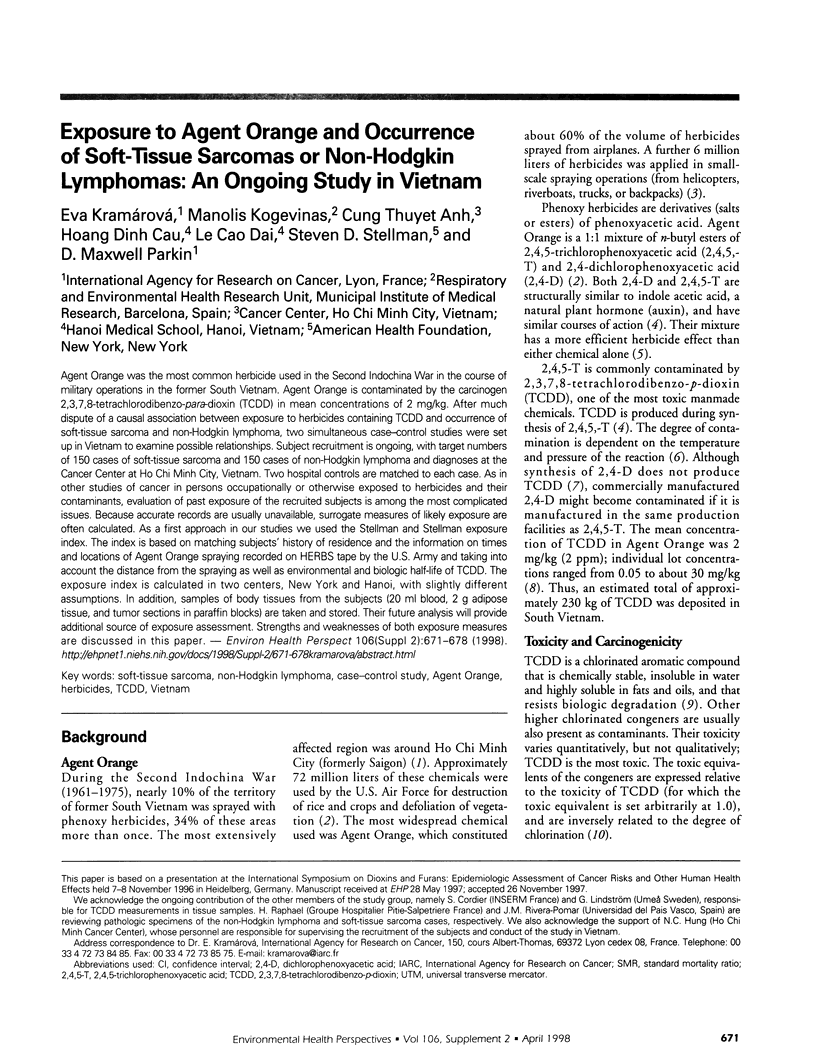
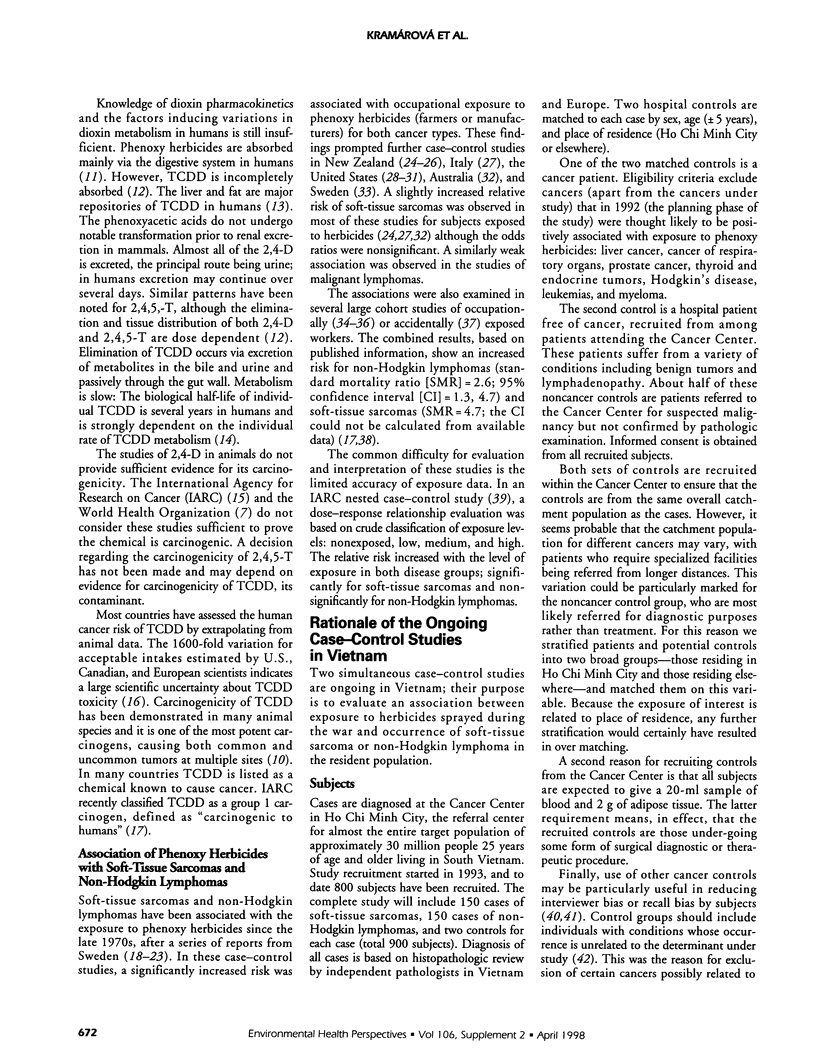

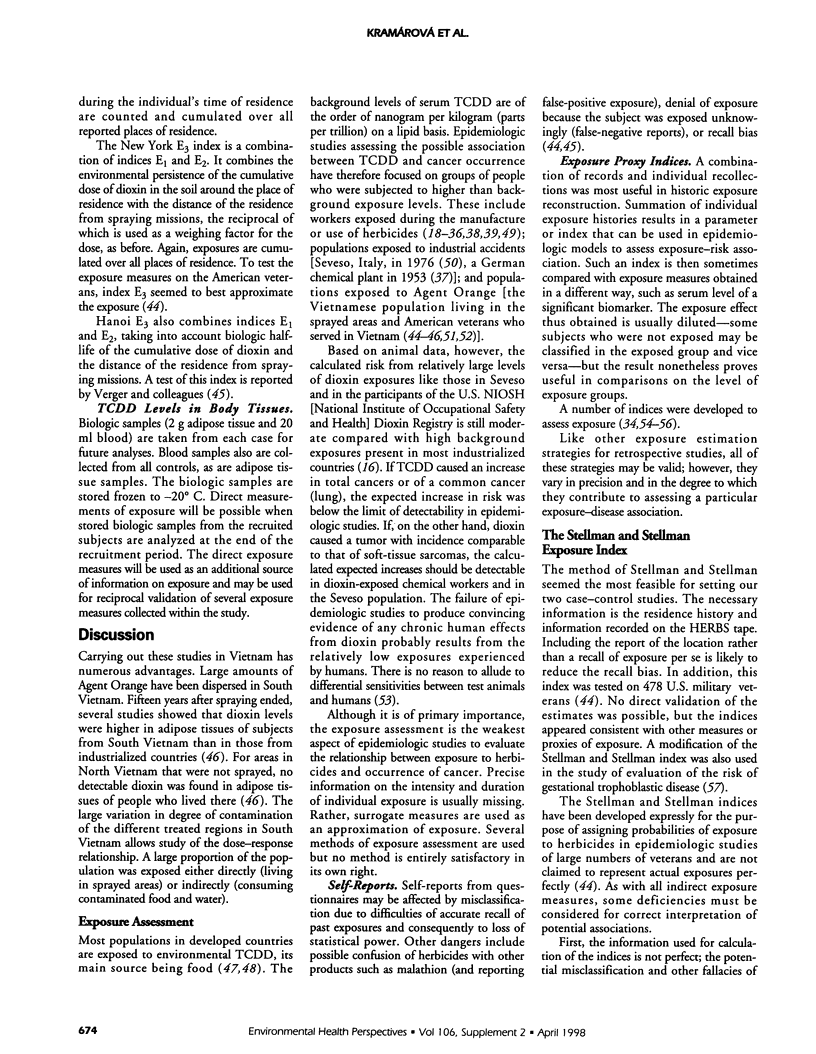
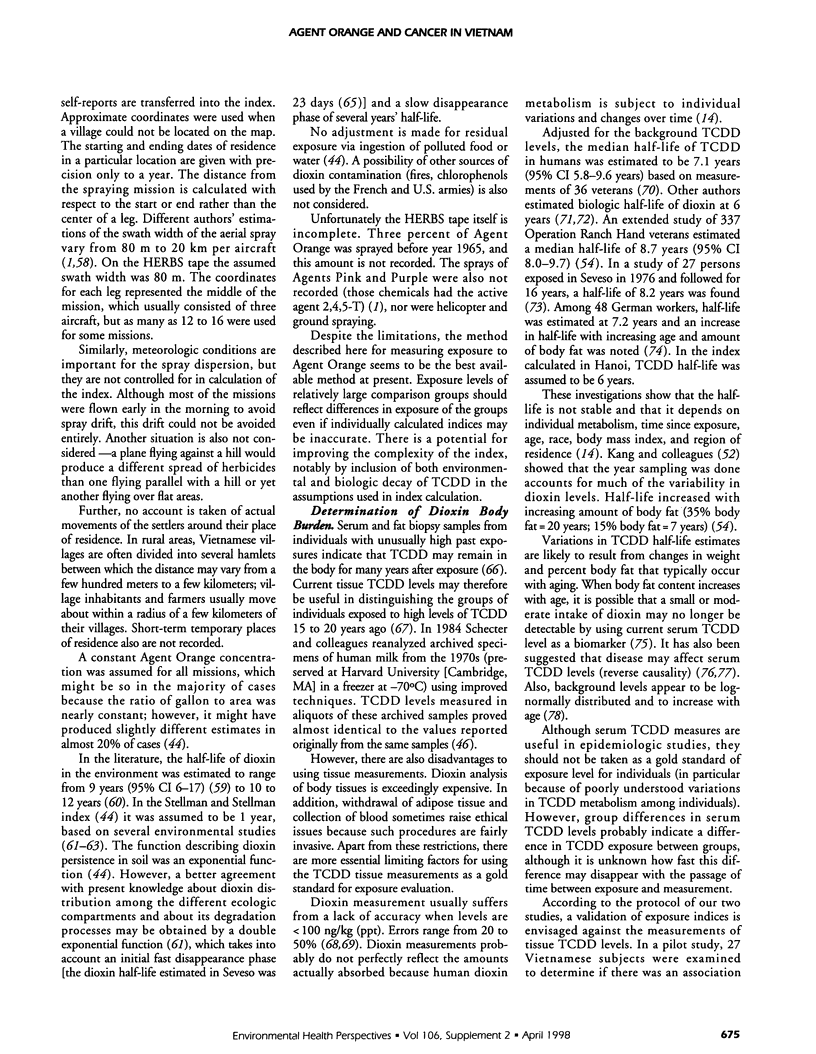
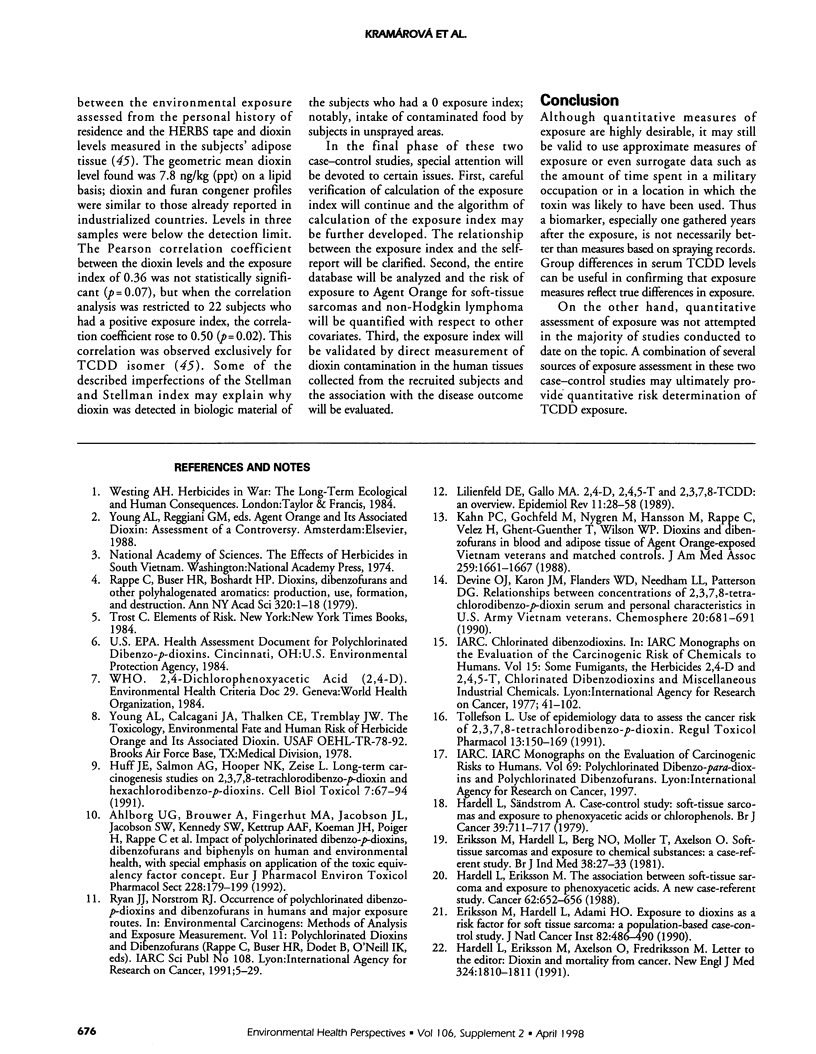

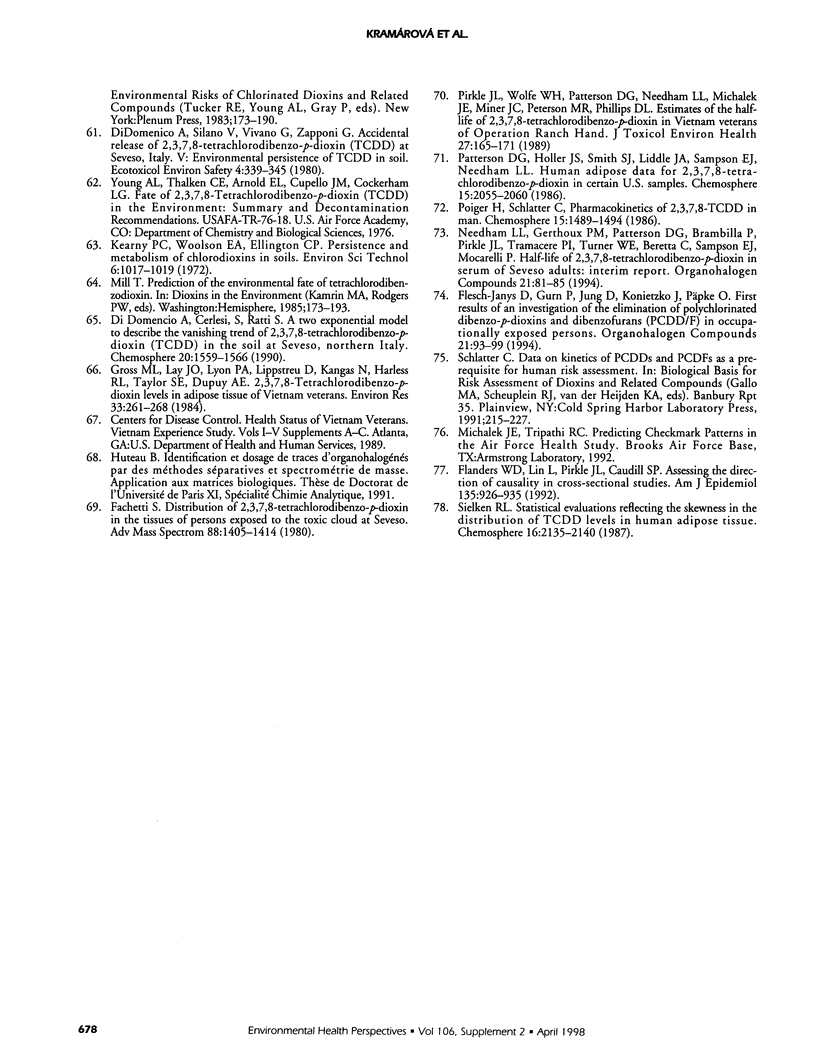
Selected References
These references are in PubMed. This may not be the complete list of references from this article.
- Ahlborg U. G., Brouwer A., Fingerhut M. A., Jacobson J. L., Jacobson S. W., Kennedy S. W., Kettrup A. A., Koeman J. H., Poiger H., Rappe C. Impact of polychlorinated dibenzo-p-dioxins, dibenzofurans, and biphenyls on human and environmental health, with special emphasis on application of the toxic equivalency factor concept. Eur J Pharmacol. 1992 Dec 1;228(4):179–199. doi: 10.1016/0926-6917(92)90029-c. [DOI] [PubMed] [Google Scholar]
- Becher H., Flesch-Janys D., Kauppinen T., Kogevinas M., Steindorf K., Manz A., Wahrendorf J. Cancer mortality in German male workers exposed to phenoxy herbicides and dioxins. Cancer Causes Control. 1996 May;7(3):312–321. doi: 10.1007/BF00052936. [DOI] [PubMed] [Google Scholar]
- Bertazzi A., Pesatori A. C., Consonni D., Tironi A., Landi M. T., Zocchetti C. Cancer incidence in a population accidentally exposed to 2,3,7,8-tetrachlorodibenzo-para-dioxin. Epidemiology. 1993 Sep;4(5):398–406. doi: 10.1097/00001648-199309000-00004. [DOI] [PubMed] [Google Scholar]
- Boroush M., Gough M. Can cohort studies detect any human cancer excess that may result from exposure to dioxin? Maybe. Regul Toxicol Pharmacol. 1994 Oct;20(2):198–210. doi: 10.1006/rtph.1994.1070. [DOI] [PubMed] [Google Scholar]
- Byard J. L. The toxicological significance of 2,3,7,8-tetrachlorodibenzo-p-dioxin and related compounds in human adipose tissue. J Toxicol Environ Health. 1987;22(4):381–403. doi: 10.1080/15287398709531081. [DOI] [PubMed] [Google Scholar]
- Cantor K. P., Blair A., Everett G., Gibson R., Burmeister L. F., Brown L. M., Schuman L., Dick F. R. Pesticides and other agricultural risk factors for non-Hodgkin's lymphoma among men in Iowa and Minnesota. Cancer Res. 1992 May 1;52(9):2447–2455. [PubMed] [Google Scholar]
- Cerlesi S., Di Domenico A., Ratti S. 2,3,7,8-tetrachlorodibenzo-p-dioxin (TCDD) persistence in the Seveso (Milan, Italy) soil. Ecotoxicol Environ Saf. 1989 Oct;18(2):149–164. doi: 10.1016/0147-6513(89)90076-6. [DOI] [PubMed] [Google Scholar]
- Erickson J. D., Mulinare J., McClain P. W., Fitch T. G., James L. M., McClearn A. B., Adams M. J., Jr Vietnam veterans' risks for fathering babies with birth defects. JAMA. 1984 Aug 17;252(7):903–912. [PubMed] [Google Scholar]
- Eriksson M., Hardell L., Adami H. O. Exposure to dioxins as a risk factor for soft tissue sarcoma: a population-based case-control study. J Natl Cancer Inst. 1990 Mar 21;82(6):486–490. doi: 10.1093/jnci/82.6.486. [DOI] [PubMed] [Google Scholar]
- Eriksson M., Hardell L., Berg N. O., Möller T., Axelson O. Soft-tissue sarcomas and exposure to chemical substances: a case-referent study. Br J Ind Med. 1981 Feb;38(1):27–33. doi: 10.1136/oem.38.1.27. [DOI] [PMC free article] [PubMed] [Google Scholar]
- Fingerhut M. A., Halperin W. E., Marlow D. A., Piacitelli L. A., Honchar P. A., Sweeney M. H., Greife A. L., Dill P. A., Steenland K., Suruda A. J. Cancer mortality in workers exposed to 2,3,7,8-tetrachlorodibenzo-p-dioxin. N Engl J Med. 1991 Jan 24;324(4):212–218. doi: 10.1056/NEJM199101243240402. [DOI] [PubMed] [Google Scholar]
- Flanders W. D., Lin L., Pirkle J. L., Caudill S. P. Assessing the direction of causality in cross-sectional studies. Am J Epidemiol. 1992 Apr 15;135(8):926–935. doi: 10.1093/oxfordjournals.aje.a116388. [DOI] [PubMed] [Google Scholar]
- Geyer H., Scheunert I., Korte F. Bioconcentration potential of organic environmental chemicals in humans. Regul Toxicol Pharmacol. 1986 Dec;6(4):313–347. doi: 10.1016/0273-2300(86)90002-4. [DOI] [PubMed] [Google Scholar]
- Gross M. L., Lay J. O., Jr, Lyon P. A., Lippstreu D., Kangas N., Harless R. L., Taylor S. E., Dupuy A. E., Jr 2,3,7,8-Tetrachlorodibenzo-p-dioxin levels in adipose tissue of Vietnam veterans. Environ Res. 1984 Feb;33(1):261–268. doi: 10.1016/0013-9351(84)90022-7. [DOI] [PubMed] [Google Scholar]
- Ha M. C., Cordier S., Bard D., Le T. B., Hoang A. H., Hoang T. Q., Le C. D., Abenhaim L., Nguyen T. N. Agent orange and the risk of gestational trophoblastic disease in Vietnam. Arch Environ Health. 1996 Sep-Oct;51(5):368–374. doi: 10.1080/00039896.1996.9934424. [DOI] [PubMed] [Google Scholar]
- Hardell L., Eriksson M., Lenner P., Lundgren E. Malignant lymphoma and exposure to chemicals, especially organic solvents, chlorophenols and phenoxy acids: a case-control study. Br J Cancer. 1981 Feb;43(2):169–176. doi: 10.1038/bjc.1981.25. [DOI] [PMC free article] [PubMed] [Google Scholar]
- Hardell L., Eriksson M. The association between soft tissue sarcomas and exposure to phenoxyacetic acids. A new case-referent study. Cancer. 1988 Aug 1;62(3):652–656. doi: 10.1002/1097-0142(19880801)62:3<652::aid-cncr2820620334>3.0.co;2-4. [DOI] [PubMed] [Google Scholar]
- Hardell L., Sandström A. Case-control study: soft-tissue sarcomas and exposure to phenoxyacetic acids or chlorophenols. Br J Cancer. 1979 Jun;39(6):711–717. doi: 10.1038/bjc.1979.125. [DOI] [PMC free article] [PubMed] [Google Scholar]
- Health effects of halogenated aromatic hydrocarbons. Ann N Y Acad Sci. 1979 May 31;320:1–730. [PubMed] [Google Scholar]
- Hoar S. K., Blair A., Holmes F. F., Boysen C. D., Robel R. J., Hoover R., Fraumeni J. F., Jr Agricultural herbicide use and risk of lymphoma and soft-tissue sarcoma. JAMA. 1986 Sep 5;256(9):1141–1147. [PubMed] [Google Scholar]
- Huff J. E., Salmon A. G., Hooper N. K., Zeise L. Long-term carcinogenesis studies on 2,3,7,8-tetrachlorodibenzo-p-dioxin and hexachlorodibenzo-p-dioxins. Cell Biol Toxicol. 1991 Jan;7(1):67–94. doi: 10.1007/BF00121331. [DOI] [PubMed] [Google Scholar]
- Kahn P. C., Gochfeld M., Nygren M., Hansson M., Rappe C., Velez H., Ghent-Guenther T., Wilson W. P. Dioxins and dibenzofurans in blood and adipose tissue of Agent Orange-exposed Vietnam veterans and matched controls. JAMA. 1988 Mar 18;259(11):1661–1667. [PubMed] [Google Scholar]
- Kang H. K., Watanabe K. K., Breen J., Remmers J., Conomos M. G., Stanley J., Flicker M. Dioxins and dibenzofurans in adipose tissue of US Vietnam veterans and controls. Am J Public Health. 1991 Mar;81(3):344–349. doi: 10.2105/ajph.81.3.344. [DOI] [PMC free article] [PubMed] [Google Scholar]
- Kogevinas M., Becher H., Benn T., Bertazzi P. A., Boffetta P., Bueno-de-Mesquita H. B., Coggon D., Colin D., Flesch-Janys D., Fingerhut M. Cancer mortality in workers exposed to phenoxy herbicides, chlorophenols, and dioxins. An expanded and updated international cohort study. Am J Epidemiol. 1997 Jun 15;145(12):1061–1075. doi: 10.1093/oxfordjournals.aje.a009069. [DOI] [PubMed] [Google Scholar]
- Kogevinas M., Kauppinen T., Winkelmann R., Becher H., Bertazzi P. A., Bueno-de-Mesquita H. B., Coggon D., Green L., Johnson E., Littorin M. Soft tissue sarcoma and non-Hodgkin's lymphoma in workers exposed to phenoxy herbicides, chlorophenols, and dioxins: two nested case-control studies. Epidemiology. 1995 Jul;6(4):396–402. [PubMed] [Google Scholar]
- Lilienfeld D. E., Gallo M. A. 2,4-D, 2,4,5-T, and 2,3,7,8-TCDD: an overview. Epidemiol Rev. 1989;11:28–58. doi: 10.1093/oxfordjournals.epirev.a036044. [DOI] [PubMed] [Google Scholar]
- Linet M. S., Brookmeyer R. Use of cancer controls in case-control cancer studies. Am J Epidemiol. 1987 Jan;125(1):1–11. doi: 10.1093/oxfordjournals.aje.a114490. [DOI] [PubMed] [Google Scholar]
- Michalek J. E., Pirkle J. L., Caudill S. P., Tripathi R. C., Patterson D. G., Jr, Needham L. L. Pharmacokinetics of TCDD in veterans of Operation Ranch Hand: 10-year follow-up. J Toxicol Environ Health. 1996 Feb 23;47(3):209–220. doi: 10.1080/009841096161744. [DOI] [PubMed] [Google Scholar]
- Miettinen O. S. The "case-control" study: valid selection of subjects. J Chronic Dis. 1985;38(7):543–548. doi: 10.1016/0021-9681(85)90039-6. [DOI] [PubMed] [Google Scholar]
- Olsson H., Brandt L. Risk of non-Hodgkin's lymphoma among men occupationally exposed to organic solvents. Scand J Work Environ Health. 1988 Aug;14(4):246–251. doi: 10.5271/sjweh.1925. [DOI] [PubMed] [Google Scholar]
- Ott M. G., Zober A. Cause specific mortality and cancer incidence among employees exposed to 2,3,7,8-TCDD after a 1953 reactor accident. Occup Environ Med. 1996 Sep;53(9):606–612. doi: 10.1136/oem.53.9.606. [DOI] [PMC free article] [PubMed] [Google Scholar]
- Pearce N. E., Sheppard R. A., Smith A. H., Teague C. A. Non-Hodgkin's lymphoma and farming: an expanded case-control study. Int J Cancer. 1987 Feb 15;39(2):155–161. doi: 10.1002/ijc.2910390206. [DOI] [PubMed] [Google Scholar]
- Pearce N., Checkoway H. Case-control studies using other diseases as controls: problems of excluding exposure-related diseases. Am J Epidemiol. 1988 Apr;127(4):851–856. doi: 10.1093/oxfordjournals.aje.a114868. [DOI] [PubMed] [Google Scholar]
- Pirkle J. L., Wolfe W. H., Patterson D. G., Needham L. L., Michalek J. E., Miner J. C., Peterson M. R., Phillips D. L. Estimates of the half-life of 2,3,7,8-tetrachlorodibenzo-p-dioxin in Vietnam Veterans of Operation Ranch Hand. J Toxicol Environ Health. 1989;27(2):165–171. doi: 10.1080/15287398909531288. [DOI] [PubMed] [Google Scholar]
- Saracci R., Kogevinas M., Bertazzi P. A., Bueno de Mesquita B. H., Coggon D., Green L. M., Kauppinen T., L'Abbé K. A., Littorin M., Lynge E. Cancer mortality in workers exposed to chlorophenoxy herbicides and chlorophenols. Lancet. 1991 Oct 26;338(8774):1027–1032. doi: 10.1016/0140-6736(91)91898-5. [DOI] [PubMed] [Google Scholar]
- Schecter A., Dai L. C., Thuy L. T., Quynh H. T., Minh D. Q., Cau H. D., Phiet P. H., Nguyen N. T., Constable J. D., Baughman R. Agent Orange and the Vietnamese: the persistence of elevated dioxin levels in human tissues. Am J Public Health. 1995 Apr;85(4):516–522. doi: 10.2105/ajph.85.4.516. [DOI] [PMC free article] [PubMed] [Google Scholar]
- Smith A. H., Pearce N. E., Callas P. W. Cancer case-control studies with other cancers as controls. Int J Epidemiol. 1988 Jun;17(2):298–306. doi: 10.1093/ije/17.2.298. [DOI] [PubMed] [Google Scholar]
- Smith A. H., Pearce N. E., Fisher D. O., Giles H. J., Teague C. A., Howard J. K. Soft tissue sarcoma and exposure to phenoxyherbicides and chlorophenols in New Zealand. J Natl Cancer Inst. 1984 Nov;73(5):1111–1117. [PubMed] [Google Scholar]
- Smith J. G., Christophers A. J. Phenoxy herbicides and chlorophenols: a case control study on soft tissue sarcoma and malignant lymphoma. Br J Cancer. 1992 Mar;65(3):442–448. doi: 10.1038/bjc.1992.90. [DOI] [PMC free article] [PubMed] [Google Scholar]
- Stellman S. D., Stellman J. M. Estimation of exposure to Agent Orange and other defoliants among American troops in Vietnam: a methodological approach. Am J Ind Med. 1986;9(4):305–321. doi: 10.1002/ajim.4700090402. [DOI] [PubMed] [Google Scholar]
- Tollefson L. Use of epidemiology data to assess the cancer risk of 2,3,7,8-tetrachlorodibenzo-p-dioxin. Regul Toxicol Pharmacol. 1991 Apr;13(2):150–169. doi: 10.1016/0273-2300(91)90019-r. [DOI] [PubMed] [Google Scholar]
- Verger P., Cordier S., Thuy L. T., Bard D., Dai L. C., Phiet P. H., Gonnord M. F., Abenhaim L. Correlation between dioxin levels in adipose tissue and estimated exposure to Agent Orange in south Vietnamese residents. Environ Res. 1994 May;65(2):226–242. doi: 10.1006/enrs.1994.1034. [DOI] [PubMed] [Google Scholar]
- Vineis P., Terracini B., Ciccone G., Cignetti A., Colombo E., Donna A., Maffi L., Pisa R., Ricci P., Zanini E. Phenoxy herbicides and soft-tissue sarcomas in female rice weeders. A population-based case-referent study. Scand J Work Environ Health. 1987 Feb;13(1):9–17. doi: 10.5271/sjweh.2077. [DOI] [PubMed] [Google Scholar]
- Woods J. S., Polissar L., Severson R. K., Heuser L. S., Kulander B. G. Soft tissue sarcoma and non-Hodgkin's lymphoma in relation to phenoxyherbicide and chlorinated phenol exposure in western Washington. J Natl Cancer Inst. 1987 May;78(5):899–910. [PubMed] [Google Scholar]
- di Domenico A., Silano V., Viviano G., Zapponi G. Accidental release of 2,3,7,8-tetrachlorodibenzo-p-dioxin (TCDD) at Sèveso, Italy. V. Environmental persistence of TCDD in soil. Ecotoxicol Environ Saf. 1980 Sep;4(3):339–345. doi: 10.1016/0147-6513(80)90035-4. [DOI] [PubMed] [Google Scholar]


